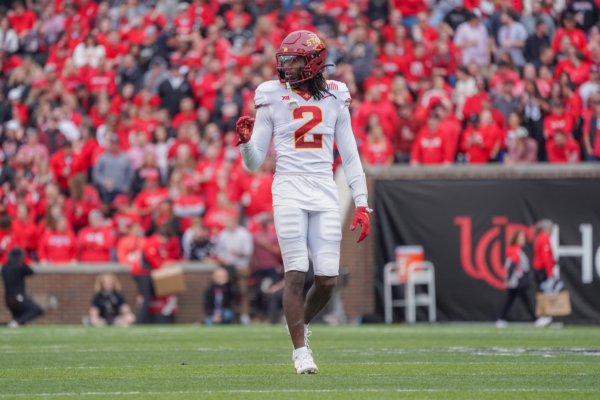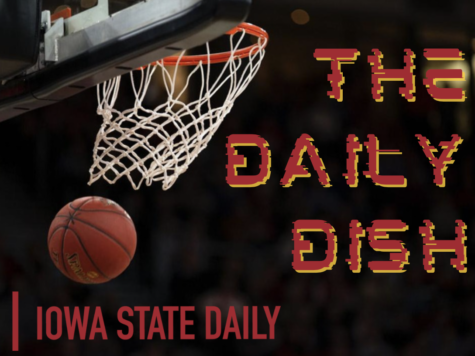GRIDIRON EDITORIAL: Big 12 play tougher than Big Ten
September 28, 2012
We’ve all heard the arguments, we’ve all drawn comparisons, we’ve all emitted arrogance with them.
Cyclone fans will contend that their team has the toughest schedule between it and Iowa, while Hawkeye fans will tout the merits of their conference slate as they puff up their chests in an effort to outdo the other.
With all due respect to the confusion their names induce — the Big 12 has 10 teams and the Big Ten has 12 — we’re here to tell you three reasons why the Big 12 is better — and tougher — than the Big Ten.
1. Numbers don’t lie: the Big 12 has been the more dominant conference.
Heading into conference play, the Big 12 has seven unbeaten teams (Baylor, Iowa State, Kansas State, TCU, Texas, Texas Tech and West Virginia) this season while the Big Ten only has three (Minnesota, Northwestern and Ohio State).
Granted, the Big Ten has one more non-conference game since it has two more teams than the Big 12. However, those non-conference games saw 13 losses to teams such as Virginia, Louisiana Tech and Ball State.
Through the first four weeks, the Big 12 has a winning percentage of .844 (27-5), while the Big Ten’s is .717 (33-13).
The quality of competition also differs between both conferences. From 2008-2011, the Big 12 finished with more 10-win teams than the Big Ten three of the four years — the only exception coming in 2009 when the Big 12 had two (Texas and Nebraska) and the Big Ten had four (Ohio State, Iowa, Penn State and Wisconsin).
Nebraska has since jumped ship from the Big 12 and joined the Big Ten starting last season, but the 10-team Big 12 still had more 10-win teams than the 12-team Big Ten.
The Big 12 has an overall 12-5 record against Big Ten teams since 2008 — including an 8-2 mark in bowl games.
If that last fact isn’t enough of an indication of the Big 12’s dominance, then we don’t know what is.
2. In what the Big 12 has lost with the departure of four teams, it has made up for with its two additions.
The Big 12 lost four teams — Nebraska and Colorado in 2010 and Texas A&M and Missouri in 2011 — but is still going strong after adding Texas Christian (TCU) and West Virginia.
The Big Ten got Nebraska, which was a big pickup to fill it out to 12 teams.
However, while Nebraska has remained consistent, it has not made it to a BCS bowl since 2001 — a 37-14 loss to Miami (Fla.) in the Rose Bowl, which served as the national title game that year.
Since that game was played, West Virginia has won three BCS bowls (2005 Sugar Bowl, 2007 Fiesta Bowl and 2011 Orange Bowl) and TCU has won one (2010 Rose Bowl).
While the overall reputations of TCU and West Virginia may not stack up against the four national championships that Nebraska has, their recent success makes them viable — maybe even superior — replacements at this time.
3. This season, all 10 Big 12 teams rank in the top 50 toughest schedules while the Big Ten only has six.
According to Phil Steele’s strength of schedules for 2012, the Big 12 has six teams in the top 25 toughest schedules while the Big Ten has four — only Michigan (4) is ranked in the top 20.
Just above Michigan is Iowa State, which has the third-toughest schedule in the nation. Iowa? Nowhere near the top 50.
The combined record from last season for Iowa State’s opponents in 2012 is 95-57 (.625), which outranks Iowa’s opponents’ combined record of 87-68 (.561).
Hawkeye fans might have been under the assumption that Cyclone fans saw Sept. 8’s Cy-Hawk game as a bowl game.
However, the reality is that Iowa State has a much tougher schedule that doesn’t include the likes of conference opponents such as sub-par Purdue (7-6 last season) and Northwestern (6-7), as well as lowly Indiana (1-11) and Minnesota (3-9).
That, coupled with a disparaged Penn State team that has been ravaged by penalty-free transfers and a four-year bowl ban following NCAA sanctions handed down from the Jerry Sandusky scandal, makes for an even easier slate for the Hawkeyes this season.
While Iowa is almost a lock for a bowl game this season — if it can even make it through Big Ten play — Iowa State will have a much tougher road ahead of it just to reach a similar outcome.
















